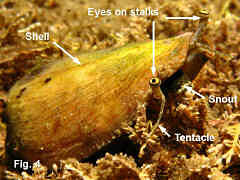|
Strombus luhuanus Linnaeus, 1758
Description: Shell solid and heavy, conical
in overall shape; spire
variable in height. Early whorls usually smooth, sometimes with axial
folds, rest of shell smooth and glossy. Aperture elongate; columella
smooth, lightly calloused; outer lip with deep posterior and stromboid
notches. Columella black, outer lip orange internally; deep interior of
aperture pink. Exterior white or pink with about seven spiral brown
bands on body whorl, with axial zigzag lines, more prominent in spiral
bands. Operculum corneous, long, thin, serrated. Periostracum brown,
thick.
Size: Up to 73 mm in length.
Distribution: Indo-West Pacific. In
Australia, Torres Strait, Queensland, southwards to Shellharbour, NSW;
also offshore reefs in north-western WA and a few isolated records on
mainland north-western WA.
Habitat: Among seagrass in intertidal and
shallow subtidal. Abundant in tropics, uncommon in NSW.
Remarks: In the tropics this species occurs
in high densities in isolated colonies. Depending on the availability of
suitable habitat the colony may migrate, usually a distance of the order
of hundreds of metres per year. Population structure and movement
characteristics were studied in populations on the Great Barrier
Reef and in southern Papua New Guinea by Catterall and Poiner (1983).
Around Sydney, the species is known from only a few colonies in
areas of suitable habitat. Juvenile shells (Fig. 3) do not have the
expanded lip and stromboid notch so characteristic of adults, and may be
mistaken for cone shells.
Fig. 1: Sinclair Bay, Queensland
(C.122403)
Fig. 2: Minnie Waters, NSW (C.320774)
Fig. 3: Juvenile shells. Shellharbour,
NSW (C.122400)
Fig. 4: Live animal. Fairy Bower, NSW,
subtidal, 2010. (Photo Richard Ling)

|